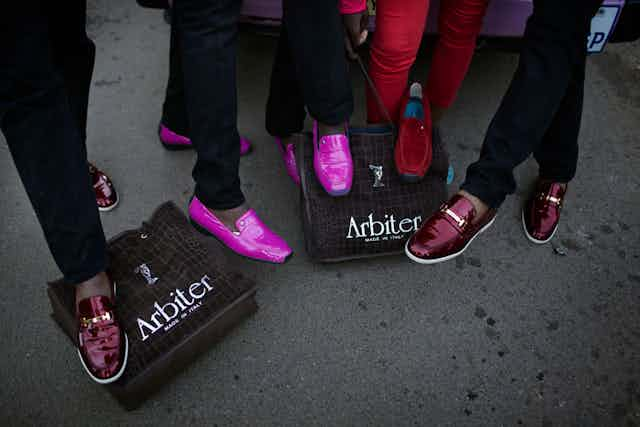In South Africa, a skhothane is a young, fashionably dressed black urban resident who engages in destructive conspicuous consumption. This involves regular get-togethers on weekends in which groups of izikhothane – most likely male teenagers – gather to compete in mock battles where luxury items are often destroyed. The name is derived from a word in the Zulu language, ukukhotha, meaning “to lick”, but in urban slang it means to boast.
There’s no consensus about when exactly this “youth craze” emerged. But there’s reason to believe the ukukhothana subculture can be traced as far back as 2005, first in the townships of the East Rand of Gauteng province before spreading to other provinces. In South Africa, townships are human settlements established outside towns and cities by the white minority apartheid government as areas for people categorised as black to live in.
At ukukhothana events, izikhothane show up wearing expensive designer labels such as Rossimoda shoes, DMD shirts and Versace jackets and suits. They also bring what, in the township context, is considered expensive junk food, such as KFC and Debonair’s Pizza. Alcohol such as Bisquit, Hennessy and Jameson, traditionally associated with affluent people, accompanies the food.
What makes the events interesting is what happens to these costly items once there’s an audience and loud music. The expensive clothes are at times torn, burnt or trampled on. The food is thrown on the ground and at each other in a playful and boastful manner. The alcohol is both consumed and used to wash hands and even poured on the ground. All this is done in order to show off wealth, style and swag, and ultimately to outdo each other in attracting cheers from the audience, attention from female spectators and respect from rival crews.
As one would expect, a subculture like this in a developing economy like South Africa has not been well received. It’s often criticised as wasteful and reckless by society and in the media. Prominent investigative journalist Debora Patta, for example, labelled izikhothane as “bling gone obscenely mad” on national TV. The question is asked: why do izikhothane embrace conspicuous consumption despite their limited means?
As communications scholars we have each studied this subculture for several years. In a recent research paper we explore the link between consumption and the idea of rehumanisation – or restoring dignity to marginalised lives. We investigate how this subculture is a form of fashion consciousness with a long history – leading on from the “diamondfield dandies” of the 1800s and the “oswenka” of the 1900s. We argue that ukukhothana is a form of expression that has the potential to reclaim a sense of selfhood and pride in the remnants of oppression in post-apartheid South Africa.
Consumption and identity
UK anthropologist Mary Douglas and UK economist Baron Isherwood suggested in 1979 that consumption is a purposeful act. It’s often aimed at conveying identity, cultural values and social circumstances. The goods people consume serve as markers of social identity and carry deeper meanings. US sociologist Thorstein Veblen’s concept of “conspicuous consumption” aptly captures this phenomenon. It refers to the act of displaying wealth and status through ostentatious spending.
Izikhothane’s behaviour can be understood within this framework. It’s an effort to signal their defiance against adversity and assert their presence in a society that has historically marginalised those who look like them. This historical marginalisation involved the treatment of black people as less than human through the system of apartheid. Black people were dehumanised during this period.
Dehumanisation involves viewing others as fundamentally different and inferior, perpetuating stereotypes and hindering empathy. Interestingly, this practice affects both the dehumanised and the dehumaniser. By devaluing others’ humanity, individuals strip themselves of their own humanising qualities. This underscores the complex psychological toll of perpetuating stereotypes.
Reversing the process of dehumanisation and reclaiming humanity is a nuanced effort that happens through a process of rehumanisation. Sartorial expression, which involves using clothing to convey identity, can play a pivotal role in rehumanisation.
Material possessions hold a significant influence over how we view other people’s identities. People use belongings not only to express who they are but to construct their “best” selves.
Diamondfield dandies and oswenka
Izikhothane are not the first and will not be the last to do this. Various sartorial subcultures appear to have arisen under conditions of dehumanisation in South Africa. These include the diamondfields dandies of the 1880s in Kimberley and the oswenka in Jeppestown in Johannesburg in the 1950s. These fashion subcultures found themselves in dehumanising conditions of migrant labour exploitation. They used expensive clothing and competitions of display to carve out a sense of their own humanity.
The diamondfield dandies sought to challenge racially inscribed stereotypes by parading in expensive clothing. They rebelled against the silence of black people in a bigoted white culture and created an identity outside work.
Years later a different kind of dandy emerged through the oswenka (swankers), who performed menial labour for work. The oswenka subculture went beyond simply parading in expensive apparel in the form of suits; it involved competitive performance battles against other dandies.
In a similar way, izikhothane’s extravagant displays of consumption serve as a means of fulfilling psychological needs.
Why this matters
Izikhothane’s seemingly frivolous consumption rituals defy the constraints of their socioeconomic backgrounds. Their fashion choices assert their existence and protest against the enduring effects of apartheid. Their actions challenge conventional notions of rebellion and provide a poignant commentary on the complexities of identity, inequality and resistance.
The izikhothane of post-apartheid South Africa show us the power of consumption to challenge social norms and resist structural injustices. Their conspicuous consumption, while seemingly destructive, can be interpreted as a way of asserting identity and demanding recognition in a society that has historically treated those who look like them as invisible and less than human.

